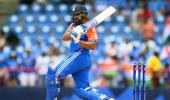'You play the percentages, and if it bounces the right way for you, something can happen.'

Euro 2024 has seen plenty of eye-catching strikes from distance to get fans out of their seats, but despite the work done on the training ground and their supposed usefulness to lower-ranked nations, set-pieces have not been a significant factor.
Even with some of the best dead-ball specialists in the world on show, set-piece goals have been few and far between, and former Sweden manager Janne Andersson told Reuters that expectations of fans can be too high -- as can the risks.
"There was a time there where some coach said you'd be better off kicking the ball wide of the goal and dropping back again because there was a bigger chance of letting in a goal than scoring one," Andersson said.
A number of penalties have been converted, but not many headers directly from corners or curling free kicks have found their way into the net.
"I don't have the current numbers, but for a while you needed around 50 corners to score one goal and if you just cross the ball in there, the defenders are big favourites to win it," Andersson said.
The 61-year-old, who stepped down as Sweden coach when they missed out on qualification for Euro 2024, revealed that managers prepare for set-pieces at tournaments in different ways.
"You become like a club team at a tournament, and there's more time for set pieces, both offensively and defensively. You don't want to let in cheap goals, so in the time we had we prioritised defending," Andersson said.
"Offensively, it's more to do with timing, and that's something you have to practise more, and we could do that at championships. You had a little more time to practice variations."
Andersson said that what can look very random at corners or free kicks is often meticulously planned.
"Every player in the box has a specific task - it might just be to run into a specific area at high speed, but it also might be to screen the goalkeeper so he can't come out. Even those outside the box are positioned according to certain principles," he said.
Movement aside, much of the success at set-pieces is down to what Andersson calls the "server" -- the player who sends the ball into the box for others to attack.
"If you have a good server, you know the ball is going to arrive at a certain point, and in that case, you can either work with principles and screen to open up that space, or open up for a specific player. It's very important to have a good server."
That also applies to one of the most under-rated forms of set-pieces.
"A long thrown-in is a damn good weapon -- Lars Lagerback did it with Iceland," Andersson said.
"You play the percentages, and if it bounces the right way for you, something can happen," he said.
That advice may well be useful in the knockout stages at Euro 2024.
"If you're chasing a game at the end and you need a chance, you know there'll be a duel and the ball might bounce to someone else in your team - it's a great weapon," Andersson said.












